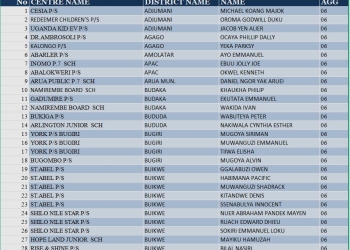Your Excellency,
This weekend, at the thanksgiving service for Minister Mary Grace Mugasa — and at various other platforms before — you expressed strong dissatisfaction with school leaders, PTAs, and School Management Committees/Boards of Governors for allegedly hijacking and undermining the purpose of Universal Primary and Secondary Education (UPE and USE).
Your argument, consistent over time, has been that UPE and USE schools should provide education at zero cost to the learner, ensuring that every child, everywhere, has access to education without barriers, as a public service. This is, in all fairness, a legitimate concern for you and for many of us who are passionate about guaranteeing education for all.
However, Your Excellency, if we are to address the root of the problem, we must ask ourselves some hard questions. Why do schools continue to charge extra fees even though they receive UPE and USE grants? This takes us to the heart of the matter — education financing.
Your Excellency, the government currently allocates Shs20,000 per learner annually for primary schools, Shs58,300 per O-Level student per term, and Shs90,000 per A-Level student per term. Consider a primary school in Isingiro with 200 learners. That school receives Shs4 million annually — about Shs1.3 million per term or roughly Shs450,000 per month. This is expected to cover all school operations, assuming there are no other revenue sources, such as parent contributions or donor support.
Let us consider the costs this money must cover:
- Hiring additional teachers to address chronic teacher–learner ratio problems
- Operational needs such as slashing the compound, building a fence for security, and facilitating meetings of PTAs and SMCs
- Headteacher’s official travel and continuous professional development
- Chalk, textbooks, learner assessments, and feeding (where applicable)
- Construction and repair of latrines and classrooms
- Security personnel salaries
Your Excellency, with only Shs1.3 million per term, how can any headteacher realistically manage these obligations without supplementing income? I submit that the charging of extra fees is not an attempt to undermine government policy but a practical response to underfunding.
The solution, therefore, is not to vilify headteachers or label them as saboteurs of government policy. Nor should zealous district and central government officials resort to arrests. Instead, government should engage school heads to understand the real challenges associated with UPE and USE grants.
Together, we could work towards a more realistic funding formula to ensure schools are adequately resourced, making the charging of fees unnecessary.
An alternative solution — which may be politically unpalatable — is to adopt a co-financing model. I understand that government may be constrained in its ability to raise the per-learner grant.
However, it could revise its position on zero parental contribution and consider a shared cost model between government and parents. The National Planning Authority, in its 2018 report on UPE financing, proposed an ideal grant per child of Shs63,546 for urban schools and Shs59,503 for rural schools — more than double the current allocation.
Government could aim to gradually meet this target over, say, five years. During this transition, parents could be asked to co-finance the shortfall, with their contribution decreasing as government support increases. Eventually, Uganda would reach a point where education is not only universal and free in policy but also in practice.
Your Excellency, allow me to raise another, more controversial but sustainable concern — the question of government-aided schools. These institutions exist at all education levels, particularly primary and secondary. The problem lies in the widespread misperception that these are government schools, when in fact they are not.
Take, for example, Ntare School — a government-founded and owned institution. Compare it with Mbarara High School, which is church-founded and only government-aided. There is a major distinction. Unfortunately, government has gradually begun to treat church-founded schools as if they were public institutions, simply because they receive government grants.
Yet the government does not own these schools and cannot issue directives to them in the same way it can to truly public institutions. This limited control is a significant obstacle to achieving education equity. Furthermore, many of these government-aided schools — particularly in the central region — charge fees comparable to, or even exceeding, private schools.
Despite receiving support in the form of teachers’ salaries, textbooks, laboratory and library facilities, these schools are not easing the financial burden on parents. The original purpose of grant-aiding in the 1960s was to supplement the efforts of faith-based institutions that had already set up schools. But the context has changed. These schools are no longer fulfilling their role in promoting education equity.
Why should a government-aided school in central Uganda charge fees similar to those of St. Lawrence Schools or St Mary’s SS Kitende, despite receiving substantial government subsidies? What, then, is government getting in return?
The state must either assume greater oversight over fee-setting in grant-aided schools or begin phasing out the grant-aiding model. Through the Ministry of Finance, Planning and Economic Development, government should calculate the total investment in grant-aided schools annually and assess how many new government-owned schools could be built with that amount over a 10-year period.
Two paths would emerge:
- Government-aided schools would be required to reduce fees to make education more affordable and accessible.
- Alternatively, government would gradually exit the grant-aiding model and invest in building its own schools — perhaps one per sub-county to start.
These new public schools would be government-owned and fully financed, providing education at zero cost. Alongside them would be church-founded or NGO-run schools (which would charge modest fees aligned with their missions) and private for-profit schools catering to those who can afford higher fees.
Under this model, Uganda would have three categories of schools:
- Public schools: Government-owned and fully subsidised, catering to the poorest families.
- Private but for impact schools: Founded by religious bodies or NGOs, charging moderate fees and focused on holistic education.
- Private for-profit schools: Owned by entrepreneurs, charging higher fees with a focus on premium services and academic performance.
This structure would address both education equity and quality. Poor families would access free education at government schools. Middle-income families would benefit from quality, values-driven education at NGO and faith-based institutions. Wealthy families would have access to elite private schools. Meanwhile, competition would drive up standards across the board.
Government would work closely with headteachers of public schools to ensure education quality. Faith-based institutions would have to justify their fees by demonstrating quality outcomes. Private schools would be held accountable for results, not just welfare and luxury.
In this way, Uganda would not only secure education for all but also raise its quality, across every tier of society.
Ms Modern Musiimenta Karema is an educator
+256781064668




















